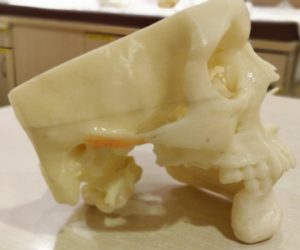Team L&M
Corporate executive and cancer survivor Prabhjeet, a resident of Faridabad in Haryana had been living without right half of his jawbone for more than seven years. It was removed during a surgery along with temporomandibular (TM) joint to cure him of cancer. The TM joint controls the mobility of the jaw. Over the years, his residual mandible deviated which prevented lower and upper jaw to meet. It affected his quality of life as he could not chew or bite his meals and was compelled to eat soft foods like daliya and khichdi. Furthermore, it caused repeated bite ulcers in his cheek leading to pain and fear of cancer relapse. He also has an underlying chronic disease in form of SLE (Sytemic Lupus Erythematosis) that affects immunity.
It is here that Dr Mandeep Singh Malhotra, Head of Department (HOD), Head, Neck & Breast Oncoplasty and his team at Fortis Flt Lt Rajan Dhall Hospital, Vasant Kunj (FHVK) stepped in and successfully planned and performed a unique and first-of-its-kind procedure to reconstruct a jaw using 3D printing technology. The titanium jaw was constructed using this novel technology and implanted it onto a 30-year-old Faridabad resident. It gave him complete control over his mouth which allowed him to chew food properly after seven years since his jaw was removed due to cancer.

Speaking about the clinical challenges, Dr Malhotra said, “The underlying SLE disease and reconstruction of the TM joint discouraged us from planning the conventional methodology of using the one’s own lower leg bone in form of Fibula to reconstruct the jawbone. With SLE it was difficult to establish blood supply to the fibula bone, this method also involved losing a bone in the leg which cannot be compensated. The TM joint reconstruction could only be done by making a prosthetic joint and inserting it. Therefore, we thought of using 3D printing technology to develop a complete prosthetic jaw including the joint component using Titanium which is the most biocompatible and light metal. The part of the joint which shall form the jacket around the upper part of prosthetic jawbone called as condyle was formed by ultra-high molecular weight polyethylene.”
Prabhjeet, of course, is a happy man. “Initially, I was unsure about it but when Dr Malhotra explained to me that there is a good chance, I went for it. Post-surgery, I was discharged after seven days. I was on liquid and soft diet for three weeks to provide time for the new jaw to get integrated. Post-physiotherapy, my jaw movements were optimised. Today, I can taste and chew any food of my choice. I would like to thank Dr Malhotra and his team for turning the impossible to possible.”